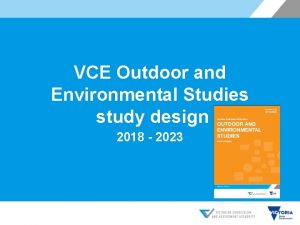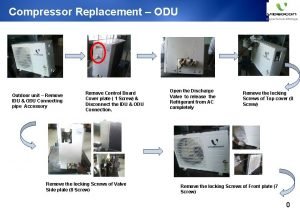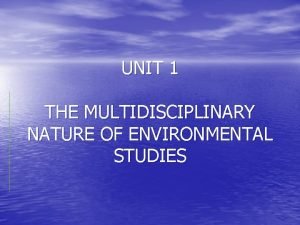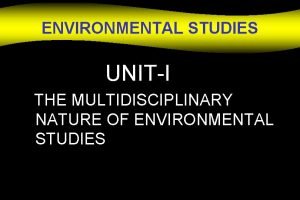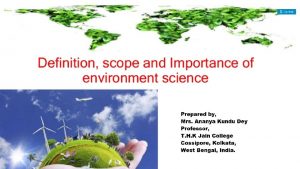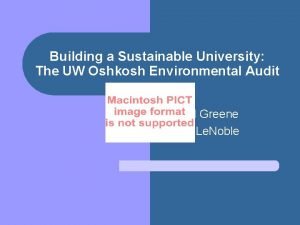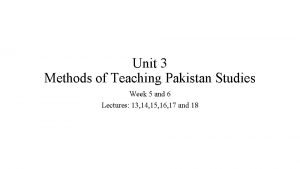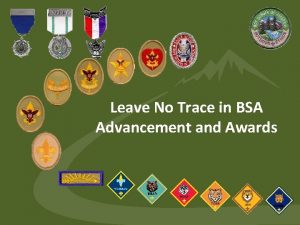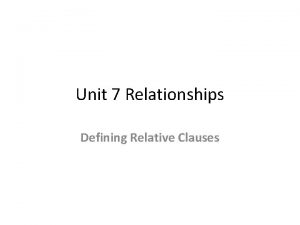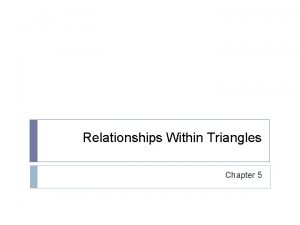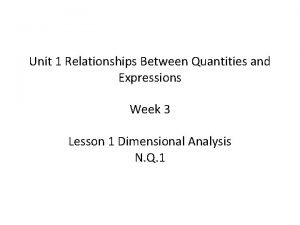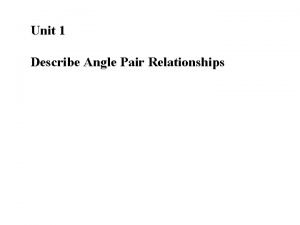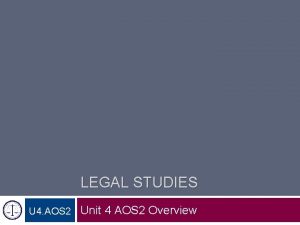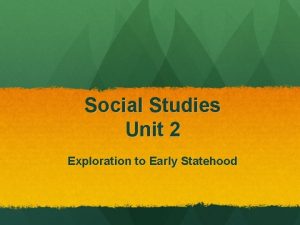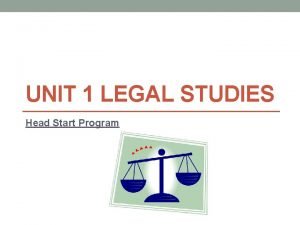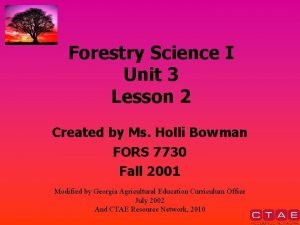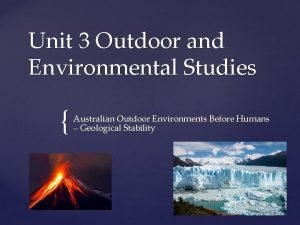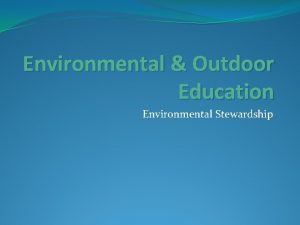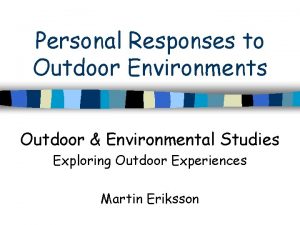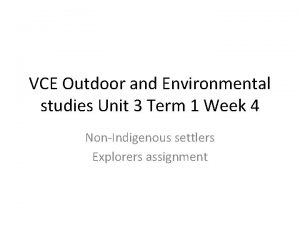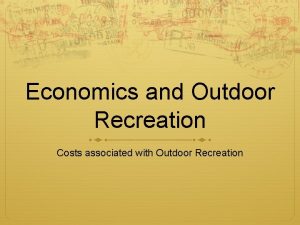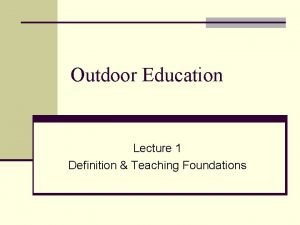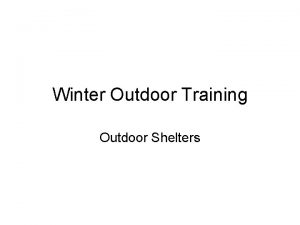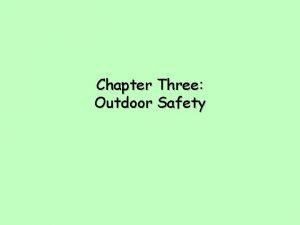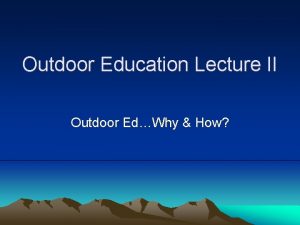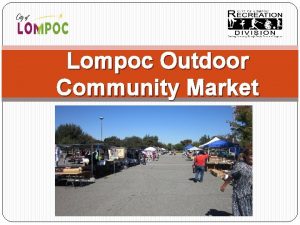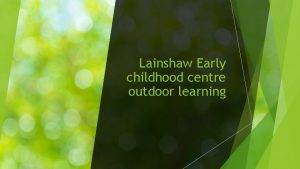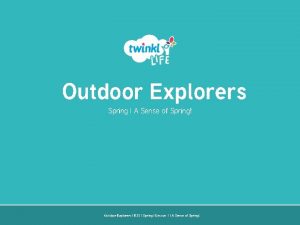OUTDOOR AND ENVIRONMENTAL STUDIES UNIT 3 2014 RELATIONSHIPS




























- Slides: 28

OUTDOOR AND ENVIRONMENTAL STUDIES - UNIT 3 2014 RELATIONSHIPS WITH OUTDOOR ENVIRONMENTS Indigenous Relationships Historical Relationships Environmental Movements Contemporary Relationships Influences on Relationships 100 100 100 200 200 200 300 300 300 400 400 400 500 500 500 Final Jeopardy

HELP (1) Save a duplicate of this template. (2) Enter all answers and questions in the normal view. (view/normal) (3) Change the category headings in the normal view (view/normal) (4) View as a slideshow. (5) Use the home red button after each question.

A-100 QUESTION: Identify the perception of the land to indigenous people in the Grampians area ANSWER: Land as mother, spiritual connection to the land etc.

A-200 • QUESTION: Identify and correctly spell the two of the tribes residing in the Grampians and surrounding areas. • ANSWER: Jardwadjali and Djabwurrung

A-300 ▪ QUESTION: Explain an interaction had by an indigenous tribe in an environment you have been to or studied and evaluate the impacts it my have had on the local environment ▪ ANSWER: ▪ Fire stick farming, lack of nomadism, canoe building, fish traps etc + evaluation of connected impacts

A-400 ▪ QUESTION: Describe how an indigenous tribes relationship with the land has evolved since European colonisation ANSWER: Perceptions rather unchanged, restrictions to movements lead to concentrated impacts, now promote education about the land leading to reduced impacts.

A-500 • QUESTION: Compare and Contrast the relationships held by an indigenous tribe in an area you have visited and studied prior to European settlement and contemporary relationships reflected through Primary industries. • ANSWER: PII of indigenous contrasted with PII of Primary industries (resource, mining/fishing, damage to land/animal populations)

B-100 ▪ QUESTION: True or False. . Quarrying that occurred at Heatherlie Quarry is an example of a perception held by Europeans during the period of Increasing population ▪ ANSWER: False (not a perception and is an example during industrialisation)

B-200 • QUESTION: Describe a major interaction that occurred in the Grampians and surrounding areas during the time of Nation Building • ANSWER: Designating Grampains and NP, Building of Bellfield dam to suffice water demands of the growing population, Increased infrastructure to access the National Park (roads and paths).

B-300 • QUESTION: Describe the relationship with the land held by first non-indigenous settlers in an environment you have visited or studied (BONUS 100 If you can name the explorer that found the Grampians during this time period) Terra Nullius and Land as adversary, land clearing for small farms/introduction of pest species, removal of habitats and increased competition for food for native species. ANSWER: Bonus = Major Thomas Mitchell

B-400 • QUESTION: Compare and Contrast the relationships held in an environment you have visited or studied during the times of Increasing population and industrialisation. • ANSWERS: Comparable = perceptions of land as a resource, Contrastable = Interactions on a larger scale during industrialisation leading to much more significant impacts.

B-500 • QUESTION: Analyse how the relationships held by our predecessors may have influenced the relationships held with the land today • ANSWER: Still seen as a resource in some cased but due to impacts of previous interactions we are developing a perception that the land needs conservation and protections to minimise our impacts into the future (learning from mistakes made – intro species etc)

C-100 • QUESTION: Who was the founder of The Tasmanian Wilderness Society? • ANSWER: Bob Brown

C-200 QUESTION: What practices have you been involved with that reflect the conservation promotion of an environmental movement (how has it changed your interactions)? ANSWER: Any minimal impact strategies you were a part of on trips. .

C-300 • QUESTION: Describe what influence the Victorian National Parks Association has had on nature conservation since its foundation • ANSWER: Involvement in the creation of ‘Friends of. . ’ groups Involvement in the protection of Alpine areas from cattle grazing. Influential input into National park conservation.

C-400 QUESTION: Describe the foundation and aims of The Wilderness Society (including key dates and events) ANSWER: Founded in 1976 as the Tasmanian Wilderness Society after the damming of Lake Pedder. The Society grew in notoriety during the Franklin river campaign where they fought to save the Franklin river from being dammed, eventually becoming “The Wilderness Society” in 1983. Their work continues today through many other environmental protection campaigns including the conservation of James price point. Their aim remains to transform Australia into a society that protects, respects and connects with the natural world that sustains us.

C-500 QUESTION: Analyse the role an environmental movement had in changing relationships with an environment you have visited or studied. ANSWER: Increased perceptions of land as a cathedral or sanctuary, increased conservation and minimal impact interactions leading to decreased environmental impacts (specific to environment chosen).

D-100 • QUESTION: Identify the 4 practices contemporary relationships are most often reflected through. • ANSWER: Conservation, Primary Industries, Recreation and Tourism

D-200 QUESTION: Define nature conservation and provide an example of how this is currently seen in an environment you have visited or studied. ANSWER: The practice of protecting or enhancing a natural place. Eg drop toilets, protection around plants, NP zoning, paths etc.

D-300 QUESTION: Define primary industries and provide an example of how this is currently seen in an environment you have visited or studied. • ANSWER: Industry, such as mining, agriculture, or forestry, that is concerned with obtaining or providing natural raw materials for conversion into commodities and products for the consumer. EG = Quarrying and agriculture.

D-400 • QUESTION: Identify the 4 practices that reflect contemporary relationships and describe how they are currently shown in an environment you have visited or studied. • ANSWER: Primary industries = agriculture in the form of grain production Conservation = drop toilets installed by Parks vic and minimal impact practices followed by visitors. Recreation = bushwalkers/rockclimbers of the Grampians Tourism = Halls gap carivan park, Brambuk cultural centre etc.

D-500 • QUESTION: Compare and contrast the relationships with an environment you have visited or studied, held through two different contemporary practices • ANSWER: Primary industries + Tourism • Compare P = land as a resource and something to make money from • Contrast I I = Agriculture has lead to large scale deforestation whilst guided tours have had minimal impact and lead to a reduction of large scale impacts in some cases.

E-100 • QUESTION: Describe how early artwork seen in the Ballarat Gallery displayed the artists perception of the outdoors • ANSWER: Light colours and happy people showing a love of being outdoors. People in distress and pale colours showed Australia to be a harsh and unforgiving environment. Perspectives can also influence dominance over or submission to the environment

E-200 • QUESTION: Identify a song that has provided a viewpoint on natural environments and describe has this may they alter your relationship with the outdoors • ANSWER: Big yellow taxi – perceive the environment as more than just a parking lot - int = engage with the outdoors more as ‘you don’t know what you’ve got till its gone’- Impact = lessened due to changed perceptions and interatcions.

E-300 • QUESTION: Identify a piece of technology and evaluate how it has influenced contemporary societal relationships with the outdoors. • ANSWER: Lightweight tents = – Has created a reduction in interactions with the outdoors leading to exclusion from the outdoors and less understandings of weather variations being gained during outdoor experiences. Overall the developments in technology have been positive for contemporary relationships though as. . + they have allowed for ease in travel and longer experiences in the outdoors

E-400 • QUESTION: Analyse how a societal response to risk may influence people’s relationships with particular outdoor environments. • ANSWER: In response to a rock climbing accident, the media may portray rock-climbing venues such as Mt Arapiles or the Grampians as hazardous and dangerous venues, leading to less people wanting to venture into these environments due to fear of death or injury the media may have exaggerated.

E-500 QUESTION: Identify two opposing discourses about climate change and how they may influence contemporary relationships with the outdoor environments. ANSWER: Arguments for climate change focus on human causal factors and information about the ocean temperature rising, erratic weather and hotter summers, which we have seen recently. This could influence relationships by encouraging people to take better care of the environment by using less energy, using fewer cars, recycling material and planting trees. However, there is also the argument that climate change is a naturally occurring process and that we don’t have enough data over a long period of time to say that these changes are caused by humans. This could influence contemporary societal relationships by leading people to believe that there is no need to care for the environment and that climate change will happen regardless of what we do, so they will not change the way they live.

FINAL JEOPARDY QUESTION: Explain what different characteristics of the Australian environment may have played a role in this Koala and the Eucalyptus tree he is sitting on evolving in such a unique fashion ANSWER: Koala = Climatic variation leading to the development of a smaller brain to conserve energy Eucalyptus = Geological Stability resulting in poor soil quality which has resulted in the development of deep roots to enable constant access to water and nutrient rich soil.
 New vce english study design 2023
New vce english study design 2023 Vrf code
Vrf code Odu outdoor unit
Odu outdoor unit Paradigm shift from women studies to gender studies
Paradigm shift from women studies to gender studies Uksn almora
Uksn almora Sunderlal bahuguna quotes in malayalam
Sunderlal bahuguna quotes in malayalam Environmental studies means
Environmental studies means Scope of environmental studies
Scope of environmental studies Importance of environmental studies
Importance of environmental studies Uw oshkosh environmental studies
Uw oshkosh environmental studies Wireless health
Wireless health Unit method of teaching
Unit method of teaching Unit 10, unit 10 review tests, unit 10 general test
Unit 10, unit 10 review tests, unit 10 general test Leave no trace awareness award
Leave no trace awareness award Outdoor sports chart
Outdoor sports chart Types of games indoor and outdoor
Types of games indoor and outdoor Pros and cons of outdoor advertising
Pros and cons of outdoor advertising Unit 7 relationships answers
Unit 7 relationships answers Unit 5 relationships in triangles
Unit 5 relationships in triangles Unit 5: relationships in triangles
Unit 5: relationships in triangles Unit 1 relationships
Unit 1 relationships Describe adjacent angles
Describe adjacent angles Legal studies unit 4 aos 2
Legal studies unit 4 aos 2 Statistical investigations unit 3 section a
Statistical investigations unit 3 section a Business studies unit 1
Business studies unit 1 Social studies unit 2 test answers
Social studies unit 2 test answers Business studies unit 1
Business studies unit 1 Legal studies unit 1
Legal studies unit 1 Environmental systems unit 3 lesson 3
Environmental systems unit 3 lesson 3
